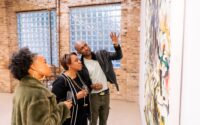Economic Survey of Artists in New York Shows 57 Percent Earn $25,000 Or Less
Data from a new survey shows the majority of artists in New York State earn less than $25,000 per year, almost two-thirds do not have emergency savings, and nearly half rely on contract or gig work.
Those are the top findings from the data collected from more than 13,300 respondents in a comprehensive survey conducted by the organization Creatives Rebuild New York (CRNY) between February and May 2022. In addition to advocating for policies which recognize artists as workers, the organization also facilitates guaranteed income and employment opportunity programs for artists in New York State.
CRNY executive director Sarah Calderon told ARTnews the “Portrait of New York State Artists” survey was conducted due to “a real lack of information on who artists are,” especially since they contribute 7.4 percent to the state’s economy. The data also provided granular information on how to evaluate its programs and how much artists were struggling as a result of the Covid-19 global pandemic. “It really became clear how much they were struggling,” she said.
The questions included inquiries into artistic practice, finances, physical and emotional health, housing, emergency financial assistance, different impacts from the Covid-19 pandemic, as well as demographic and geographic information.
Out of all the survey respondents, more than 75 percent lived in New York City; 42.4 percent were between the ages of 25 to 34 years of age; 37.9 percent were white and 29.5 percent were Black or African American; 18.2 percent were immigrants to the United States; and 42.6 percent identified as lesbian, gay, bisexual, transgender, queer/questioning, intersex, asexual/aromantic, or pansexual.
Out of 14 artistic disciplines, visual arts was selected by 3,225 respondents (24.1 percent) as their main discipline, followed by music (21.9 percent), and theater (8.5 percent).
Data analysis by ARTnews showed that 33 percent of the visual art respondents identified as solo artists; 4 percent said they collaborated regularly with other artists; 78 percent said they experienced barriers to pursuing education or professional development opportunities that advance their artistic or cultural practice; and half (49.7 percent, compared to 45.8 percent for all artists) said their financial capacity meant they could only afford some of the necessary materials, training, space, or assistance engage in their artistic practice.
Many of the visual artists who responded to CRNY’s survey said their financial situation was dire, with 42 percent describing it as “unstable” compared to 40.1 percent for all artists. More than half, 56 percent, of the visual arts respondents said their estimated household income in 2021 was $25,000 or less. Nearly 60 percent said they wouldn’t be able to cover an unexpected $400 emergency without using credit.
“We knew this intuitively, we knew this instinctively, anybody who works in the arts, you know, this, but to have that data and to be able to say, it, clearly, I think helps make the case for some of the, as Sarah said, the policy and advocacy work that we’re doing around labor protections,” Jamie Hand, CRNY’s Director of Strategic Impact and Narrative Change, told ARTnews.
Hand also noted the question of emergency cash yielded a particularly striking data point. Among all artists, 62 percent said they did not have emergency savings. “But then if you look just explicitly among black respondents, it jumps to 78 percent,” she said.
CRNY is encouraging nonprofit organizations or sponsored individuals working on advocacy campaigns to apply for grants of up to $15,000 to further analyze the data collected in this survey. Both are also available for download and online analysis through the National Archive of Data on Arts and Culture (NADAC), a data repository funded by the National Endowment for the Arts.



